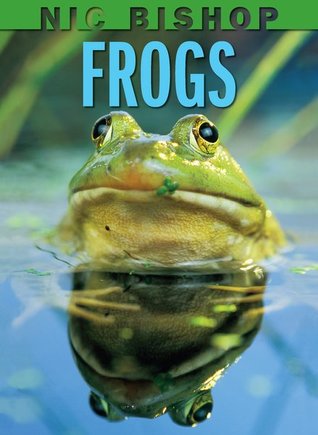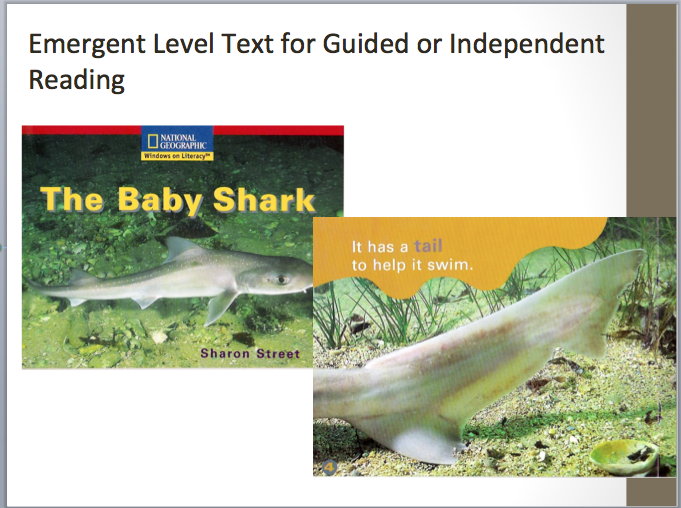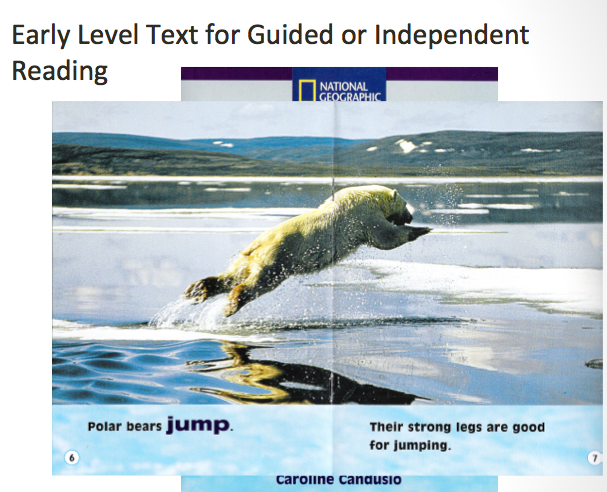
Emergent and early reader texts are frequently about animals and include action words like swim, hop, and jump. The trade books we choose to read aloud to students can serve to build, reinforce, and expand this type of vocabulary. For example, in Nic Bishop’s Frogs (2008), frogs wriggle, grip, burrow, climb, catch, swallow, blink and prey — all within two pages of text.
I don’t shy away from reading more complex texts like Bishop’s to kindergarten and first grade students. They love books like these and are hungry for the knowledge they gain. But I also don’t read aloud the whole book – they don’t have the stamina for that.
Here’s a rough outline of a lesson for kindergarten and first grade with Nic Bishop’s Frogs that includes reading aloud, shared writing and reading, and independent or partner reading–
- Show the book cover and several pages in the book to the students. Engage in a dramatic “ooo” and “aah” as the students look at these fascinating photographs.
- Read aloud 4-5 pages from the text (that you’ve chosen in advance or that students choose)- or more depending on the students’ stamina. These pages do not have to be from the beginning of the book or in consecutive order–that’s the beauty of informational texts!
- As you read, keep an eye out for action words and alert the students to do the same. (I’d definitely read the book in advance and know where these words are most prevalent–like the two pages I mentioned earlier). During a lesson with kinder, when I read aloud a sentence with an action word–I made my eyes big and slowed down. This signal cued the students that we’d read an action word worthy of stopping for and acting out After doing this a few times – they were ready and recognized when I’d read a word we could act out. I don’t stop and make up an action for every single action word — just the ones that seem worthy of attention.
- Make up actions – on the spot and/or with the students – for the words that pop up. For example, with a group of kindergarten students I was reading aloud to – I made up actions for burrow, climb, pounce, leap and so forth. I don’t spend a lot of time on this – I just quickly make up an action–impromptu.
- Each time you finish a page, review “What have we learned that frogs can do?” And go through the words and actions with the students as though reading off a list. “We know frogs can swim [action] and burrow [action] and pounce [action].”
- Engage in shared writing–writing a series of sentences–“What did we learn frogs can do?”
- Engage in shared reading during shared writing. After composing and writing each sentence, reread the previous sentences as well as that one.
- If possible, manageable, feasible, include having the students read with a partner from emergent/early level, even Pre-A, texts. Have the books ready in the students’ book bags or ready to be handed out. I go to the school’s leveled library (if there’s one) and just start pulling books about animals so that we have enough for everyone (at their level). Or you can create boxes of these books and students sit in groups and pull one at a time to read independently or with a partner. Below are two examples of the kinds of texts I pull out. (Love National Geographic Windows on Literacy books!!!)
- You might also engage the students in independently writing one fact they learned and illustrating for a class book. “We are authors just like Nic Bishop!” You might include a sentence frame or take dictation to support particular students.


Other books on my shelf that I might use…in a series of similar lessons –
- Additional books by Nic Bishop
- Wolfsnail: A Backard Predator by Sarah Campbell
- How Many Ways Can you Catch a Fly? by Steve Jenkins and Robin Page
- How Many Baby Pandas? by Sandra Markle (this one has to be read from beginning)
- What Bluebird Do by Pamela Kirby (this one has to be read from beginning)
- Grandma Elephant’s in Charge by Martin Jenkins
I’d definitely read the books in advance and determine what might work. Feel free to skp to certain parts or just read the captions or whatever you need to do to help students access meaning from the text, you know?
Okay…just some ideas I wanted to share.
Sunday
